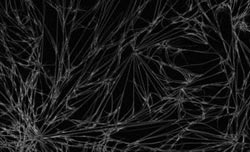Drug development: Clever crystals

Fibrous caffeine crystals as viewed by dark field light microscopy. Points where nucleation occurred are clearly visible; nucleation occurred at the points the fibrous crystals radiate out from. 1.559 ìm per pixel, the entire image covers an area of approximately 11 x 7 mm. © Zephyris<br>
There is much more to drug development than simply identifying a potent active pharmaceutical ingredient (API). Scientists must ensure that the API can tolerate the production process, remain stable during storage and distribution, and behave appropriately inside the patient’s body after administration.
One emerging technique for improving the performance of APIs with non-ideal physicochemical properties is to co-crystallize them with a second compound that modulates their behavior. Srinivasulu Aitipamula and co-workers at the A*STAR Institute of Chemical and Engineering Sciences have now developed a novel route for preparing such co-crystals.
The researchers have discovered that adding water droplets can help to form co-crystals of caffeine, a compound known to act as a central nervous system stimulant and a muscle relaxant. Caffeine is inherently unstable to humidity — a property that can be improved by forming co-crystals with biocompatible compounds such as 4-hydroxybenzoic acid (4HBA). Computer models predict that co-crystals of caffeine and 4HBA in the ratio of 1:1 should form the most stable structure. To date, however, researchers have only been able to produce 2:1 and 1:2 co-crystals.
Aitipamula and his team have now successfully formed 1:1 co-crystals of caffeine and 4HBA, in the form of a monohydrate. By grinding together a 1:1 mixture of the two components along with two drops of water, a crystal structure was formed in which each pair of crystallization partners is partly held together by a water molecule.
According to Aitipamula, the key to water’s ability to produce the 1:1 co-crystal is its capacity to both donate and accept hydrogen bonds — the intermolecular force that holds co-crystals components together. “In the case of the caffeine-4HBA co-crystal hydrate, unused hydrogen bond acceptors and donors are satisfied by forming hydrogen bonds with the water molecule,” he says. Without water, the number of hydrogen bond donors and acceptors is unbalanced, resulting in the preferential formation of the 2:1 and 1:2 crystals instead.
The process also works for other APIs, as the researchers have found. They have generated a 1:1 co-crystal hydrate of 4HBA with piracetam, a drug used to treat memory and balance problems. The results suggest that forming hydrates offers an alternative way to generate co-crystals with particular ratios of constituents, expanding the options for forming pharmaceutical materials.
The researchers are currently focused on developing new co-crystals for APIs and studying their physicochemical properties. “Our primary emphasis is to target APIs that pose problems in pre-formulation and dissolution,” Aitipamula says.
The A*STAR-affiliated researchers contributing to this research are from the Institute of Chemical and Engineering Sciences
References:
Aitipamula, S., Chow, P. S. & Tan, R. B. H. Co-crystals of caffeine and piracetam with 4-hydroxybenzoic acid: Unravelling the hidden hydrates of 1:1 co-crystals. CrystEngComm 14, 2381–2385 (2012).
Media Contact
All latest news from the category: Life Sciences and Chemistry
Articles and reports from the Life Sciences and chemistry area deal with applied and basic research into modern biology, chemistry and human medicine.
Valuable information can be found on a range of life sciences fields including bacteriology, biochemistry, bionics, bioinformatics, biophysics, biotechnology, genetics, geobotany, human biology, marine biology, microbiology, molecular biology, cellular biology, zoology, bioinorganic chemistry, microchemistry and environmental chemistry.
Newest articles

“Nanostitches” enable lighter and tougher composite materials
In research that may lead to next-generation airplanes and spacecraft, MIT engineers used carbon nanotubes to prevent cracking in multilayered composites. To save on fuel and reduce aircraft emissions, engineers…

Trash to treasure
Researchers turn metal waste into catalyst for hydrogen. Scientists have found a way to transform metal waste into a highly efficient catalyst to make hydrogen from water, a discovery that…

Real-time detection of infectious disease viruses
… by searching for molecular fingerprinting. A research team consisting of Professor Kyoung-Duck Park and Taeyoung Moon and Huitae Joo, PhD candidates, from the Department of Physics at Pohang University…





















